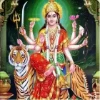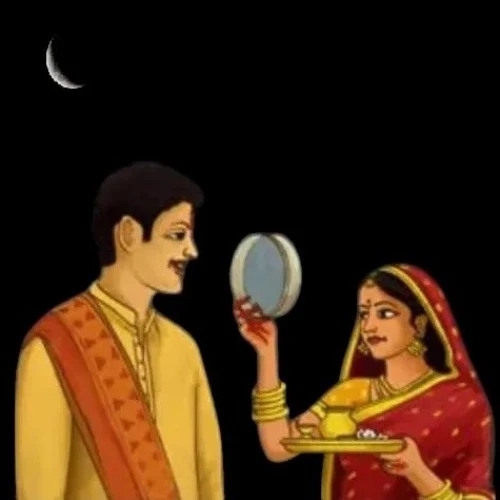Karwa Chauth is an important Hindu festival celebrated especially by married women for the long life of their husbands and a happy married life. The festival is celebrated with great enthusiasm and devotion in the northern parts of India, especially in Punjab, Haryana, Uttar Pradesh, Rajasthan, and Madhya Pradesh.
Significance of Karwa Chauth
Karwa Chauth has a deep religious and cultural significance. On this day, married women observe a Nirjala Vrat (without water and food) throughout the day and break their fast only after worshipping the moon at night. This fast is observed for the long life, good health, and happy married life of the husband.
This festival also has social significance, as it manifests love, dedication, and mutual cooperation in marriage.
Karwa Chauth Ki Katha
The legend of Karwa Chauth is narrated in many versions, but the most famous tale is associated with a beautiful queen named Veervati. The story goes like this:
Once upon a time, there was a beautiful and pious woman named Veervati. She was the only sister of seven brothers and was married to a king. After marriage, Veervati kept her first Karva Chauth fast. She was observing the fast by staying hungry and thirsty all day, but as the day passed, she became extremely weak due to hunger and thirst. Seeing her condition, her brothers were very worried about her.
The brothers tried to convince their sister to break the fast, but Veervati refused to break the fast without seeing the moon. The brothers, seeing their sister's condition, made a plan. They lit a lamp on a tree and made it look as if the moon had risen. Veervati obeyed her brothers and broke the fast after seeing the fake moon.
On breaking the fast, her husband suddenly died. Seeing this, Veervati became very sad and started repenting. Goddess Mata was pleased with her dedication and repentance and she realized the mistake of her fast. The Goddess told her that she had broken the fast after seeing the fake moon, which led to the death of her husband.
Veervati took a firm resolve and kept the Karwa Chauth fast with a true heart, worshipping Durga Maa throughout the year. The next year, the Goddess was pleased with her dedication on the day of Karwa Chauth and brought her husband back to life. Since then, the Karwa Chauth fast is observed for the long life and safety of the husband.
This story gives the message that a fast observed with love and trust between husband and wife is always fruitful by the grace of the gods and goddesses.
Karwa Chauth fast and puja vidhi
The puja vidhi of Karwa Chauth fast is as follows:
Fast preparation: A day before the fast, women receive special material for Karwa Chauth from their in-laws or parents, which is called "Sargi". Sargi consists of dry fruits, sweets, and other food items, which are eaten before sunrise.
Preparation for Puja: On the auspicious occasion of Karva Chauth, women do Solah Shringar, which is a symbol of their good fortune and love for their husband. On this day, they dress up specially and worship a Karva (earthen pot) filled with water. Wheat, rice, turmeric, kumkum, and flowers have special significance in the puja thali, which are used ritually. During the puja, the mythological story of Karva Chauth is heard, in which prayers are offered for the long life of the husband and a happy married life. All the women together perform this puja collectively, which shows the social and cultural specialty of this festival.
Worship of the Moon: When the moon rises at night, the most important moment of the fast of Karva Chauth comes. Women look at the moon through a sieve, which is considered a symbol of purity and dedication. After Chandra Darshan, they pray for the long life, good health and happy life of their husband. After this, the husband gives water to his wife, thereby breaking her fast. This moment symbolizes the deep love, trust, and dedication between husband and wife, which reflects the spiritual and cultural significance of Karva Chauth.
Karva Chauth Rituals and Traditions
Solah Shringar: On this day, women apply Solah Shringar, which includes bindi, sindoor, bangles, mehndi, and other jewellery. It is considered a symbol of a woman's good fortune.
Mehndi Rachana: A day before Karva Chauth, women apply mehndi on their hands. The darker the color of the mehndi, the more their husbands are believed to love them.
Sargi Ka Bhojan: Before the fast, women eat sargi, which is given by their mother-in-law, in the morning before sunrise. This helps in keeping the fast, as sargi contains foods that provide energy for the whole day.
Listening to the story of the fast: It is mandatory to listen to the mythological story of Karva Chauth during the puja. In this story, the story of Goddess Parvati, Lord Shiva, and Veervati is prominent.
Karva Chauth in Modern Times
Although this festival was traditionally celebrated by married women, nowadays in many places men also observe this fast along with their wives, so that both can pray for each other's long life and health. Moreover, Karva Chauth has become a social and cultural celebration, where women fast together, and their Solah Shringar and traditions make this day special.
Karva Chauth is a symbol of love and devotion of married women towards their husbands. This fast not only holds religious and cultural significance, but also promotes trust and devotion in married life. Karva Chauth puja and fast is also a social celebration, which brings happiness and devotion in the lives of women.









